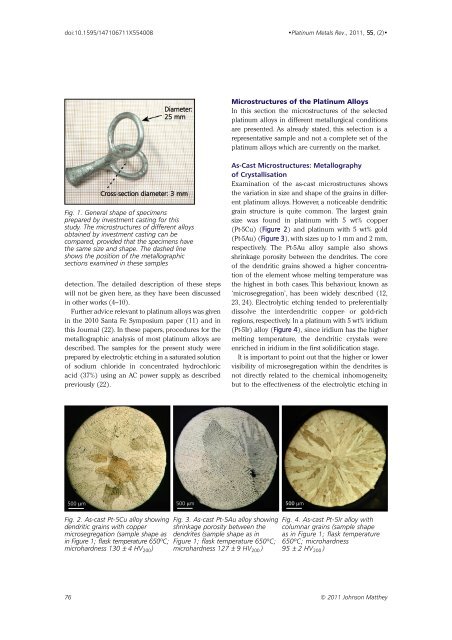Download - Platinum Metals Review
Download - Platinum Metals Review
Download - Platinum Metals Review
You also want an ePaper? Increase the reach of your titles
YUMPU automatically turns print PDFs into web optimized ePapers that Google loves.
doi:10.1595/147106711X554008<br />
•<strong>Platinum</strong> <strong>Metals</strong> Rev., 2011, 55, (2)•<br />
Diameter:<br />
25 mm<br />
Cross-section diameter: 3 mm<br />
Fig. 1. General shape of specimens<br />
prepared by investment casting for this<br />
study. The microstructures of different alloys<br />
obtained by investment casting can be<br />
compared, provided that the specimens have<br />
the same size and shape. The dashed line<br />
shows the position of the metallographic<br />
sections examined in these samples<br />
detection. The detailed description of these steps<br />
will not be given here, as they have been discussed<br />
in other works (4–10).<br />
Further advice relevant to platinum alloys was given<br />
in the 2010 Santa Fe Symposium paper (11) and in<br />
this Journal (22). In these papers, procedures for the<br />
metallographic analysis of most platinum alloys are<br />
described. The samples for the present study were<br />
prepared by electrolytic etching in a saturated solution<br />
of sodium chloride in concentrated hydrochloric<br />
acid (37%) using an AC power supply, as described<br />
previously (22).<br />
Microstructures of the <strong>Platinum</strong> Alloys<br />
In this section the microstructures of the selected<br />
platinum alloys in different metallurgical conditions<br />
are presented. As already stated, this selection is a<br />
representative sample and not a complete set of the<br />
platinum alloys which are currently on the market.<br />
As-Cast Microstructures: Metallography<br />
of Crystallisation<br />
Examination of the as-cast microstructures shows<br />
the variation in size and shape of the grains in different<br />
platinum alloys. However, a noticeable dendritic<br />
grain structure is quite common. The largest grain<br />
size was found in platinum with 5 wt% copper<br />
(Pt-5Cu) (Figure 2) and platinum with 5 wt% gold<br />
(Pt-5Au) (Figure 3), with sizes up to 1 mm and 2 mm,<br />
respectively. The Pt-5Au alloy sample also shows<br />
shrinkage porosity between the dendrites. The core<br />
of the dendritic grains showed a higher concentration<br />
of the element whose melting temperature was<br />
the highest in both cases. This behaviour, known as<br />
‘microsegregation’, has been widely described (12,<br />
23, 24). Electrolytic etching tended to preferentially<br />
dissolve the interdendritic copper- or gold-rich<br />
regions, respectively. In a platinum with 5 wt% iridium<br />
(Pt-5Ir) alloy (Figure 4), since iridium has the higher<br />
melting temperature, the dendritic crystals were<br />
enriched in iridium in the first solidification stage.<br />
It is important to point out that the higher or lower<br />
visibility of microsegregation within the dendrites is<br />
not directly related to the chemical inhomogeneity,<br />
but to the effectiveness of the electrolytic etching in<br />
500 µm 500 µm<br />
500 µm<br />
Fig. 2. As-cast Pt-5Cu alloy showing<br />
dendritic grains with copper<br />
microsegregation (sample shape as<br />
in Figure 1; flask temperature 650ºC;<br />
microhardness 130 ± 4 HV 200 )<br />
Fig. 3. As-cast Pt-5Au alloy showing<br />
shrinkage porosity between the<br />
dendrites (sample shape as in<br />
Figure 1; flask temperature 650ºC;<br />
microhardness 127 ± 9 HV 200 )<br />
Fig. 4. As-cast Pt-5Ir alloy with<br />
columnar grains (sample shape<br />
as in Figure 1; flask temperature<br />
650ºC; microhardness<br />
95 ± 2 HV 200 )<br />
76 © 2011 Johnson Matthey
















